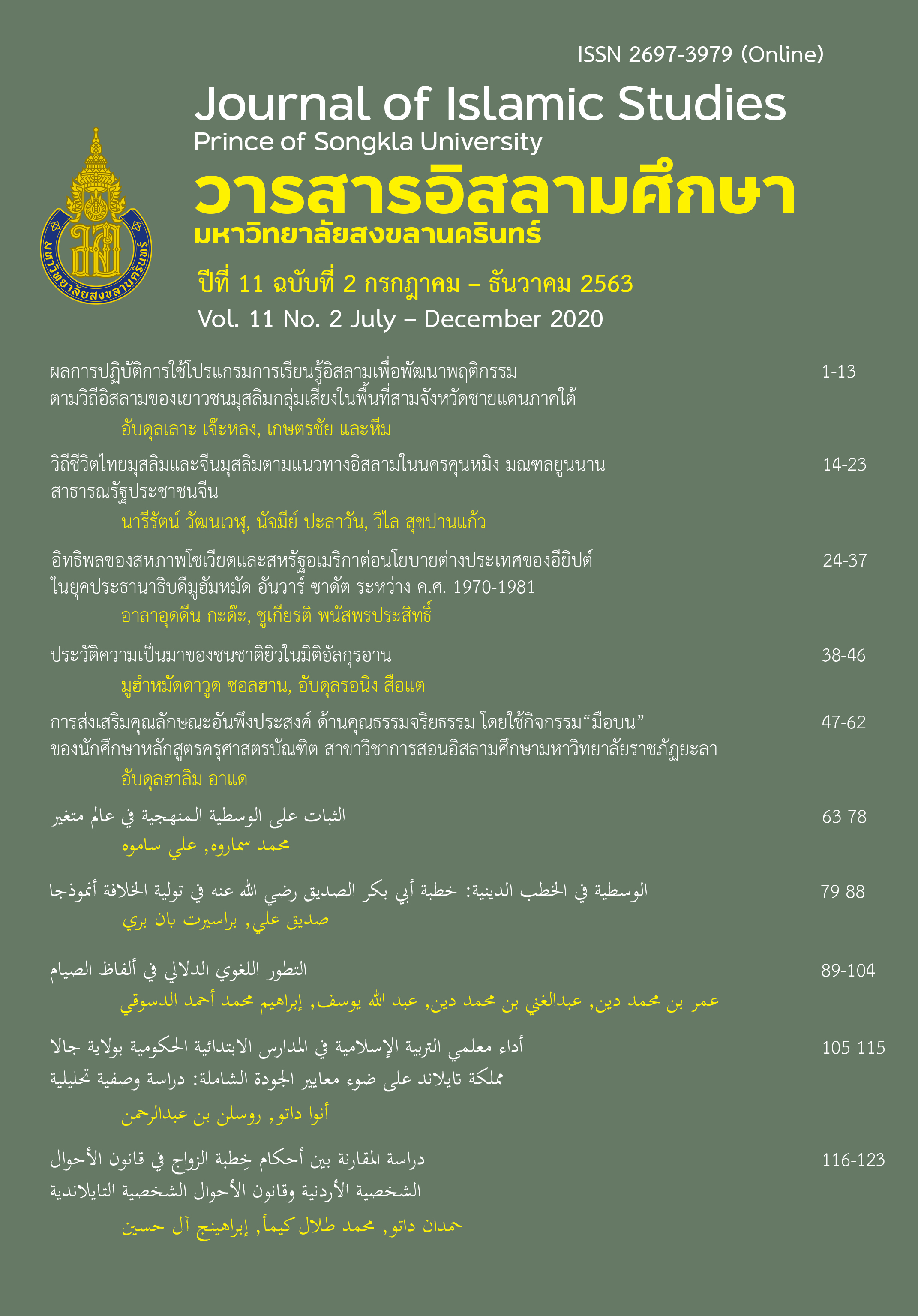วิถีชีวิตไทยมุสลิมและจีนมุสลิมตามแนวทางอิสลามในนครคุนหมิง มณฑลยูนนาน สาธารณรัฐประชาชนจีน
คำสำคัญ:
ไทยมุสลิม, จีนมุสลิม, นครคุนหมิงบทคัดย่อ
การศึกษาวิจัยเชิงคุณภาพเรื่องนี้มีวัตถุประสงค์เพื่อศึกษาเปรียบเทียบวิถีการดำเนินชีวิตตามแนวทางอิสลามของชาวไทยมุสลิมและชาวจีนมุสลิมในนครคุนหมิง มณฑลยูนนาน สาธารณรัฐประชาชนจีน โดยศึกษาจากเอกสารและการสัมภาษณ์ชาวไทยมุสลิม 11 คน ชาวจีนมุสลิม 10 คน รวม 21 คน และนำเสนอโดยการพรรณนา ผลการวิจัยพบว่า ชาวไทยมุสลิมที่เดินทางไปนครคุนหมิงในช่วงแรกต้องปรับตัวเรื่องสภาพอากาศและอาหารการกิน นครคุนหมิงมีร้านอาหารอิสลามและสถานที่ประกอบศาสนกิจหลายแห่ง การดำเนินชีวิตตามแนวทางอิสลามของชาวไทยมุสลิมและชาวจีนมุสลิมไม่แตกต่างกันเพราะนับถือพระเจ้าองค์เดียวกัน มีการประกอบศาสนกิจและมีเทศกาลสำคัญเหมือนกัน มีเพียงการแต่งกายและรายละเอียดในการประกอบศาสนกิจที่แตกต่างกัน
References
พีรยศ ราฮิมมูลา. (2525). อิสลามในประเทศจีน. ปัตตานี: แผนกวิชารัฐศาสตร์ คณะมนุษยศาสตร์และสังคมศาสตร์
มหาวิทยาลัยสงขลานครินทร์.
วิศรุต เลาะวิถี. (2559). การเรียนรู้ในมิติของอิสลาม. วารสารมนุษยศาสตร์และสังคมศาสตร์ มหาวิทยาลัยรังสิต, 12(21), 7-19.
สำนักส่งเสริมและการศึกษาต่อเนื่อง มหาวิทยาลัยสงขลานครินทร์. (ม.ป.ป.). รอมฎอนเพื่อชีวิต: รวมสาระจากรายการ สถานีวิทยุ ม.อ. และกองทัพภาคที่ 4 ค่ายสิรินทร. ปัตตานี: ผู้แต่ง.
สุชาติ เศรษฐมาลินี. (2550). การปรับเปลี่ยนอัตลักษณ์ของชาวมุสลิมยูนนานในภาคเหนือของประเทศไทย. วารสาร สังคมศาสตร์, 9(2), 23-58.
สถานกงสุลใหญ่ ณ นครคุนหมิง. (2560). ข้อมูลทั่วไปของนครคุนหมิง. สืบค้นจาก shorturl.at/pwN08
สืบค้นเมื่อ 19 กุมภาพันธ์ 2561
อับดุลเลาะ หนุ่มสุข. (2543). อิสลามกับความหลากหลายของมุสลิม: แตกต่างแต่ไม่แตกแยก. วารสารวิทยาลัยอิสลาม ศึกษา,1(1), 33-45.
China Population. (2020). สืบค้นจาก
https://baike.baidu.com/item/%E4%B8%AD%E5%9B%BD%E4%BA%BA%E5%8F%A3 สืบค้น เมื่อ 7 ตุลาคม 2563
Ma Xingdong. (2000). A Summary of Yunnan Hui Studies since the 1980s. Journal of Yunnan University of the Nationalities, 17(3), 52-58.
National Ethnic Affairs Commission of the People’ s Republic of China. (2019). Huizu. สืบค้นจาก
https://baike.baidu.com/reference/130303/6009wvCkUYLswedY0PooRQvZm4tgXsyiznZ BVkyIzBg665j8l4OIbxgWcRpYgcHrZCLtPIELqbl5OZ4q2aLEgsevvJ36mKdHpsv5 สืบค้นเมื่อ 5 ตุลาคม 2563
Weng Qianlin. (1990). A Summary of Guangxi Hui and Hui Studies. Journal of Guangxi University of the Nationalities, (1), 23-28.
Zhao Fawang. (2018). Shaoshu Minzu Jihua Shengyu Zhengce. สืบค้นจาก
http://china.findlaw.cn/ask/baike/54433.html สืบค้นเมื่อ 10 ตุลาคม 2563
Downloads
เผยแพร่แล้ว
How to Cite
ฉบับ
บท
License
บทความทุกเรื่อง ที่ได้รับการตีพิมพ์ในวารสารอิสลามศึกษาเป็นแนวคิดของผู้เขียน มิใช่เป็นความคิดเห็นคณะผู้จัดทำและมิใช่ความรับผิดชอบของคณะวิทยาการอิสลาม กองบรรณาธิการไม่สงวนสิทธิ์การคัดลอก แต่ให้มีการอ้างอิงแสดงที่มา





